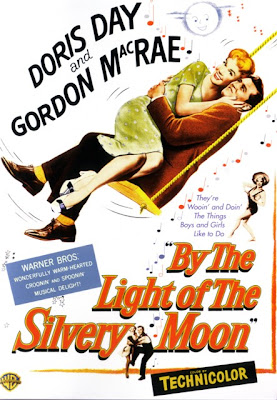BY THE LIGHT OF THE SILVERY MOON (Warner Bros. 1951) Warner Home Video

David Butler’s By The Light of the Silvery Moon
(1953) is a cordial wrap-up and sequel of sorts to Roy Del Ruth’s On
Moonlight Bay (1951), as it marked Doris Day’s final association with
Gordon MacRae. The two had made 5 movies together. Ever a definitive example of
style and song triumphing over substance – the movie, once again cribbing from
Booth Tarkington’s Penrod Stories, is an effervescent concoction of
musical vignettes, skillfully strung together in Irving Elinson and Robert
O’Brien’s adroit and often humorous screenplay. By now, Doris Day had proven
she could act with practically anyone and be a hit. Indeed, in this same year
Day would have one of her biggest hits with Calamity Jane (1953) and, in
just 3-short-years, prove she could do without singing ‘mostly’ and perform
better than most dramatic actresses of her vintage in Hitchcock’s remake of The
Man Who Knew Too Much. Shameless, I know, but it is impossible for this
reviewer to remain unbiased when reviewing any movie in which Day appeared.
Whatever the material, however rudimentary the script, Day could always be
counted upon to rise above it all, belt out a few tunes with her inimitable
warmth, and carry – not only the picture – but also ‘the day’ with her most
ardent fans.
Plot wise: Will Sherman (Gordon MacRae) returns from
WWI. But his hasty pre-war proposal to Marjorie Winfield (Doris Day) is not
nearly as close to his heart as it once was – all the worse for Marjorie who
cannot wait for Will’s return; a chronic source of consternation for Marjorie’s
father, George (Leon Ames). Loosely based on Tarkington’s Penrod stories, the
subplots are varied and largely forgettable, including one involving actresses,
who want to rent the Winfield’s barn, but who take on a spurious coloring when
Marjorie’s younger brother, Wesley (Billy Gray) thinks the eldest is
romantically after their father. Again, plot is not as essential as the
characterizations and settings. Wisely recalling the importance of their
supporting cast; Mary Wickes returns as the irrepressible maid, Stella.
Rosemary DeCamp, as Mother Winfield, is the ideal foil for her blustering
husband…and Gordon MacRae – given a more intensive stint as a dancer, proves
that although he is no Gene Kelly, he was amiable enough and remarkably light
on his feet. For the rest, Day and MacRae flesh out the story with another
bumper crop of Tin Pan Alley standards; the melodic, I’ll Forget You,’
playfully coy, Be My Little Bumble Bee and spirited Ain’t We Got Fun.
Warner Home Video’s DVD exhibits a fine Technicolor
transfer. Colors, for the most part, are bold vibrant and true to their
original spectrum. Flesh tones lean heavily to pasty pink. levels are nicely
realized. Blacks are deep and solid. Whites, generally clean – though
occasionally adopting a slight bluish tint. Technicolor misregistration occurs
sporadically throughout. The audio Dolby Digital 1.0 mono – adequate, though
just. Short subjects are the only extra
feature. By the Light of the Silvery Moon truly was the end of an
era in musicals at Warner Bros. No longer could the studio afford to make the
intimate ‘disposable’ movie musical in the fifties – fast becoming a decade of
extremes and ‘bigger than life’ spectacles. On the cusp of these changing times, Day
would prove she could segue from one generation to the next – and even, the
next and then some, becoming a beloved treasure and hold-over from Hollywood’s
ancient dream factories. We sincerely miss Doris Day, and even more sincerely
hope she is somewhere ‘up there’ warbling tunes of glory to the angels, on
whose wings her voice here on earth brought a wholesome joy to the masses.
FILM RATING (out of 5 - 5 being the best)
3
VIDEO/AUDIO
3
EXTRAS
1


Comments